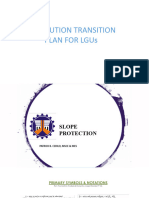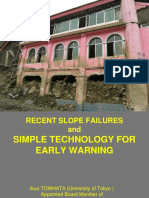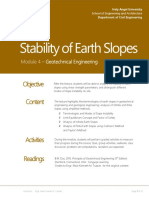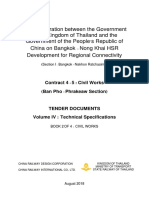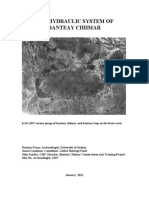Professional Documents
Culture Documents
Role of Instrumentation in Slope Monitoring A Case Study
Original Title
Copyright
Available Formats
Share this document
Did you find this document useful?
Is this content inappropriate?
Report this DocumentCopyright:
Available Formats
Role of Instrumentation in Slope Monitoring A Case Study
Copyright:
Available Formats
Volume 11, Issue 3, March 2023 International Journal of Innovative Science and Research Technology
ISSN No:-2456-2165
Role of Instrumentation in Slope Monitoring:
A Case Study
1
R.S. Sehra (Scientist-D); 2Vipin Kumar (Assistant Research Officer)
Central Soil and Materials Research Station,
New Delhi
Abstract:- Unstable and high cutting rock slopes are D. Wedge failure:
inevitably encountered during the construction of dams, The wedge failure is also referred to as block failure or
powerhouses, quarries, highways, housing developments plane slope failure and it occurs along an infinite plane. It
works, etc. in the mountainous regions. Monitoring of mostly happens when the wedges and distinct blocks of the
these slopes through instrumentation and using soil mass get separated. It is also common when there is a
transmission technology may provide immediate soil layer that has the weak bearing capacity, joints, or
warning to people living in these areas from hazards. fissures and the slope has two different materials.
Many types of instruments such as extensometers, tilt-
meters; inclinometers etc. and their data transmission This is similar to translation failure and the main
systems are available for such monitoring. Types/causes difference is that the translation failure occurs in the
of slope failure and need/importance of geotechnical situation of the finite slope only but the wedge failure occurs
instrumentation have been discussed in this paper. In in both conditions (finite and infinite slopes).
addition, a case study of slope monitoring of Vyasi dam
powerhouse through instrumentation has been also Some of the major causes are defined briefly as follows:
presented. Earthquake.
Rainfall.
I. INTRODUCTION Erosion.
Construction Work.
Unstable slopes affect almost every state in all types of Geological characteristics.
geographies, whether the slopes are owned embankments External loading.
and cut slopes or hazards originating from beyond-the-right-
of-way. It is classified into four types: Effects of Slope Failure:
Slope failure causes landslides that may cause loss of
A. Rotational failure: life and properties.
Face or slope failure: This failure occurs on the surface It reduces the bearing capacity of the soil.
of the slope which is passed through the toe of the slope. Damage to the road causes slope failure.
It happens when the soil is above the toe which contains It significantly affects humans and their lives.
weak strata.
Toe failure: This is the most common type failure in Prevention of Slope Failure:
which the failure plane is passed through the toe of the Following measures are taken to preventing the slope
slope. failures:
Base failure: The failure which is occurred in the weak Proper drainage to reduce the waterlogging and seepage
soil strata and failure plane passes through of base of the forces.
slope is called base failure. Benching
Terracing
B. Translational failure:
Build retaining walls
This type of failure occurs in an infinite slope (the slope
Rock bolts to maintain the stability of rock.
which has no boundaries) in which the movement of the soil
is along the level surface. It happens, mostly in the layered Plantation
material, usually fail along geologic discontinuities such as II. SLOPE MONITORING BY
faults, joints, bedding surfaces, or the contact between two INSTRUMENTATION
rock types. They move out or down along a planar surface
with little tilting, and can travel great distances. The two most important parameters to monitor by
instrumentation are groundwater levels and displacement
C. Compound failure: those influence the stability of slope. Piezometers allow the
It is the combination of translation and rotational failure. determination of ground water levels and extensometers,
In this condition, the failure surface is curved at two ends, inclinometers, and tilt-meters allow determination of
and plain at the middle portion, and generally, this happens, direction and rate of slope movement an indication of
when the hard stratum is below the toe at considerable displacement magnitude.
depth.
IJISRT23MAR1420 www.ijisrt.com 2016
Volume 11, Issue 3, March 2023 International Journal of Innovative Science and Research Technology
ISSN No:-2456-2165
A. Piezometers: vibration can be sensed by the electromagnetic coil and is
Piezometers should be considered at sites where frequent transmitted to a readout device. One end of the sensing wire
groundwater measurements are required (e.g. a site where is attached to a diaphragm that can be deformed by water
rapid groundwater fluctuations are suspected or where pressure entering through a porous tip. An increase in water
measurements are required during a critical event i.e. pressure from elevated piezo-metric levels reduces the
rainfall etc.). Vibrating wire piezometer shows in figure 1, tension in the wire by deforming the diaphragm inward. The
works on the same principle as tuning a guitar or piano magnetic coil in the piezometer “plucks” the wire to vibrate
(SINCO, 1994). it. The wire is plucked using variable excitation frequencies
and then allowed to return to its natural frequency. The
A steel wire is stretched over a distance. The wire is magnetic coil then acts as a sensor which is used to “count”
set to vibrating by “plucking” it with an electromagnetic the number of vibrations. The output signal is then
field. The natural frequency of the wire is a function of the converted into units of pressure or head.
tension in it. By reducing or increasing tension in the wire,
the frequency becomes lower or higher. The frequency of
Fig. 1: Vibrating Wire Piezometer
Probe inclinometers, “in-place” inclinometers, tilt- D. “In-Place” Inclinometers:
meters, and extensometers can be used alone or in “In-place” inclinometers can detect new movement, an
combination to monitor slope movement (Dunnicliffe, acceleration of movement, and the direction of movement.
1993). “In-place” inclinometers are installed in a borehole cased
with inclinometer casing. The wiring for the inclinometer
B. Inclinometers: can be buried and the boring covered with a locking cap to
It measures angles of inclination from the vertical in two vandal-proof the installation. The field setup of In-Place
planes oriented at 90° (orthogonal) to each other. The probe Inclinometer is shown in figure 2.
senses horizontal deviation between the probe axis and the
vertical plane, simultaneously in the ‘X’ and ‘Y’ directions.
C. Probe inclinometers:
These require manual operation while the other sensors
can be read electronically. The electronic sensors can be
coupled with a data logger for automated data collection.
These automated systems also can be combined with
telemetry to allow remote data collection. Additional
programming of the remote data collection system can be
used to trigger a warning of critical situations.
IJISRT23MAR1420 www.ijisrt.com 2017
Volume 11, Issue 3, March 2023 International Journal of Innovative Science and Research Technology
ISSN No:-2456-2165
Fig. 2: Field setup of In-Place Inclinometer
E. Tilt meters: device. They are an option for those sites that are too steep
Tilt-meters are also detected new movement, an for a drill rig or if the project budget does not allow for
acceleration of movement, and the direction of movement. drilling. Tilt-meters also can be covered with a vandal-proof
Tilt-meters are mounted at the ground surface. They may be enclosure and wires can be buried. Details of Tilt meter is
portable or fixed in place and they are rapid easy reading shown in figure 3.
Fig. 3: Details of Digital Tilt Meter
F. Extensometers: Movement of the slope pulls the weight along the graduated
Monitor axial movement /deformation in soil and rock at track. The amount and rate of movement can then be
various depths using rods of different lengths with reference measured manually. They are very inexpensive, but critical
to the instrument head shown in figure 4. Simple mechanical events can be missed if readings are not taken in a timely
extensometers use a steel wireline firmly connected to a fashion. These installations are also susceptible to vandalism
fixed location on the slope face on one end and to a track- and animal damage.
mounted weight, located off the slide, on the other end.
IJISRT23MAR1420 www.ijisrt.com 2018
Volume 11, Issue 3, March 2023 International Journal of Innovative Science and Research Technology
ISSN No:-2456-2165
Fig. 4: schematic arrangement of mechanical extensometers
G. Total Station: a particular point. Total station may also use for the
A total station is an electronic/optical instrument used in movement of the slope through monitoring some fixed point
modern surveying. The total station is an electronic in a slope. Figure 5 shows the Robotic Total Station with
theodolite (transit) integrated with an electronic distance Prism Targets.
meter (EDM) to read slope distances from the instrument to
Fig. 5: Robotic Total Station with Prism Targets
IJISRT23MAR1420 www.ijisrt.com 2019
Volume 11, Issue 3, March 2023 International Journal of Innovative Science and Research Technology
ISSN No:-2456-2165
III. TIME DOMAIN REFLECTOMETRY (TDR) to locate breaks and faults in communication and power
lines, its first geotechnical use was around 1980 to locate
Time domain reflectometry (TDR) is a relatively new shear zones in underground coal mines (Wade and Conroy,
approach to monitoring slope movement (Beck and Kane, 1980).
1996; Kane and Beck, 1994, 1996a, 1996b; Mikkelsen,
1996; O’Connor and Dowding, 1999). Originally developed
Fig. 6: Components of TDR system for monitoring slope movement
Time Domain Reflectometry is a technique in which If water infiltrates a TDR cable, it will change the cable’s
electronic pulses are sent down a length of a coaxial cable electrical properties and may make signatures difficult to
which has been grouted in a drill-hole. When deformation or interpret.
a break in the cable is encountered, a signal is reflected
giving information on the subsurface rock mass deformation IV. INSTRUMENTATION CASE STUDY
shown in figure 6. TDR cables are gaining popularity and
have several advantages over traditional inclinometers Vyasi hydroelectric project of 120 (2×60) MW
(Kane, 1998): capacity is a run of the river scheme situated on river
Lower cost of installation. Yamuna in Uttrakhand. The project consists of powerhouse
structures that require stability assessment. It is imperative
Deeper hole depths possible.
that long term stability of these structures is ascertained
Rapid and remote monitoring possible.
from geotechnical instrumentation program. Due to the
Immediate deformation determinations. project settings in Himalayas, it is anticipated that the
TDR readings can easily be automated. project may experience either rock burst conditions or
Complex installations possible. squeezing ground conditions. Therefore, it is important to
measure deformation and rock pressure concurrently. The
Some Disadvantages also:
rock pressure measurements started since December 01,
TDR cannot determine the actual amount of movement. 2020 near the power house. Measurements at all the places
Relative amounts can Kane and Beck - 6/20 be estimated. are continuously observed and their analysis is reported.
The direction of movement cannot be ascertained from a Total nos. of instruments installed is given in table no.1 and
TDR signature. photographs are shown in figure 7 below:
The cable must be deformed before movement can be
located. Simple bending of the cable, without damage,
will not indicate any movement.
Sr. No Type of the Instrument Quantity
1 Inclinometers 06
2 Piezometers 10
3 Load Cells 28
Total 44
Table 1: Details of Instruments
IJISRT23MAR1420 www.ijisrt.com 2020
Volume 11, Issue 3, March 2023 International Journal of Innovative Science and Research Technology
ISSN No:-2456-2165
Surface Power House & back slope Cables Anchors
Load Cell Junction Boxes/Nodes
Fig. 7: Photographs of instruments and junction boxes
Fig. 8: Schematic View of Inclinometer installation showing in X and Y Directions
V. DATA ANALYSIS AND INTERPRETATION
Fig. 9: Daily Variation in Pore Pressure Fig.10: Daily Variation in Load
IJISRT23MAR1420 www.ijisrt.com 2021
Volume 11, Issue 3, March 2023 International Journal of Innovative Science and Research Technology
ISSN No:-2456-2165
Fig. 11: Cumulative monthly deviations in IPI-3
VI. CONCLUSION Monitoring for Quarry Site of Sunni Dam, SJVNL,
District Shimla, Himanchal Pradesh, Indian
The daily variation of pore water pressure (MPa) of Institute of Technology (ISM) Dhanbad.
piezometer, load (ton) variation of load cell and monthly [4.] Jami M. Girard1 , P.E., C.M.S.P. “Assessing and
deviation with respect of depth of in-place inclinometer is Monitoring open pit mine high walls” Report on
shown graphically in figures 9, 10 and 11 respectively. “Time Domain Reflectometry for Monitoring Slope
Movements” Department of Civil and Architectural
As per the geology, folds, faults, joints, and stratified Engineering University of Wyoming 1000 E.
rocks are potential zones for the movement/ deformation University Avenue Laramie, Wyoming 82071
and storage of ground water. The pore water pressure is August 2006.
main affecting parameter in case of slope stability analysis.
The groundwater level has a major influence on material
behavior (drained-untrained), and changes in groundwater
level can result in settlements and damage to structures and
infrastructure. Geotechnical instrumentation plays an
important role in the monitoring of all such parameters like
deformation, ground water etc which affects the stability of
slope.
It is advisable to monitor the ground water level and
movement in the slope area by piezometers, probe
inclinometers; “in-place” inclinometers, tiltmeters, and multi
point borehole extensometers so that the destruction caused
by landslide can be drastically reduced by an effective
forewarning above system that can mitigate risks and loss to
human lives and infrastructure.
REFERENCES
[1.] William F. Kane, President and Principal Engineer,
KANE Geo Tech, Inc and Timothy J. Beck
Associate Engineering Geologist California
Department of Transportation “Instrumentation
practice for slope monitoring” Submitted for
Publication in: "ENGINEERING GEOLOGY
PRACTICE IN NORTHERN CALIFORNIA"
Association of Engineering Geologists.
[2.] Dunnicliff,J.,1993, Geotechnical instrumentation
for monitoring field performance: John Wiley &
Sons, Inc., New York, Project Report of Vyasi H.E.
Project (2 x 60 MW), Dakpathar, Dehradun
(Uttarakhand).
[3.] Slope Stability Report, Design, Numerical
Modeling, Kinematic Analysis, Slope Stability &
Protection Works Including Slope Health
IJISRT23MAR1420 www.ijisrt.com 2022
You might also like
- Slope Stability in Open Cast MinesDocument8 pagesSlope Stability in Open Cast MinesMarco Olivier100% (6)
- Slope Stab Lity LandslideDocument11 pagesSlope Stab Lity LandslidekriscbdrNo ratings yet
- An Analysis of Slope Reinforcement Using The Vegetation Method at Way Sekampung Dam LampungDocument12 pagesAn Analysis of Slope Reinforcement Using The Vegetation Method at Way Sekampung Dam LampungInternational Journal of Innovative Science and Research TechnologyNo ratings yet
- Slope 2Document47 pagesSlope 2Det KomerdeviNo ratings yet
- Swinburne University of Technology, Australia: Geotechnical Instrumentation Used During Dam ConstructionDocument5 pagesSwinburne University of Technology, Australia: Geotechnical Instrumentation Used During Dam ConstructionShehan FernandoNo ratings yet
- Unit 2 StabilityDocument21 pagesUnit 2 StabilityjatinsaiwaltechnoxNo ratings yet
- An Introduction To Seismology: Chapter-1Document14 pagesAn Introduction To Seismology: Chapter-1Rahul C GorheNo ratings yet
- Week 1 (2) - Geophysical SurveyDocument34 pagesWeek 1 (2) - Geophysical SurveyMUSLIHAH AQILAH MUSAFFENDYNo ratings yet
- Chapter 1Document71 pagesChapter 1Javier CaballeroNo ratings yet
- Application of Genetic Algorithm in Slope Stability AnalysisDocument14 pagesApplication of Genetic Algorithm in Slope Stability Analysismanojsharma7466No ratings yet
- 10 Slope InstrumentationDocument28 pages10 Slope InstrumentationramamurthiNo ratings yet
- Application of Geological Investigation: Reporters: MembersDocument18 pagesApplication of Geological Investigation: Reporters: MembersDaryl PenafloridaNo ratings yet
- Topic 2: Ground Geological Faults and Their Effects On BuildingDocument8 pagesTopic 2: Ground Geological Faults and Their Effects On BuildingVincent NG'ETICHNo ratings yet
- Engr. John Michael GargulloDocument4 pagesEngr. John Michael GargulloHendrix Rivera OrtegaNo ratings yet
- 10 Slope Monitoring PDFDocument29 pages10 Slope Monitoring PDFNaeem Akhtar SamoonNo ratings yet
- FAULT CLASSIFICATION AND TERMINOLOGY GUIDEDocument26 pagesFAULT CLASSIFICATION AND TERMINOLOGY GUIDETanim SyedNo ratings yet
- Lecture-1 EQ CharacteristicsDocument31 pagesLecture-1 EQ CharacteristicsHazemNo ratings yet
- 1 Basic Concept of Disaster and Disaster RiskDocument68 pages1 Basic Concept of Disaster and Disaster RiskBarbie CoronelNo ratings yet
- Slope Protection - DTP1Document75 pagesSlope Protection - DTP1Dominador O. MatbaganNo ratings yet
- Seismic DesignDocument16 pagesSeismic Designmarian07kNo ratings yet
- EqDocument30 pagesEqChar CharNo ratings yet
- Influence of Earthquake On Slope StabilityDocument12 pagesInfluence of Earthquake On Slope StabilityEder Gamarra AlvarezNo ratings yet
- EART 118 Seismotectonics: MWF D250 9:30-10:40 Am TH D250 2:00-4:00 PMDocument55 pagesEART 118 Seismotectonics: MWF D250 9:30-10:40 Am TH D250 2:00-4:00 PMDina'cupmo RiSna NArisNo ratings yet
- Earthquake Resistant Design FundamentalsDocument15 pagesEarthquake Resistant Design FundamentalsYasserMohsenNo ratings yet
- T1. Fundamentals of SeimologyDocument54 pagesT1. Fundamentals of SeimologyAbraham KefelegnNo ratings yet
- Debris Flow Early WarningDocument101 pagesDebris Flow Early WarningDinny Kus AndianyNo ratings yet
- Earthquake Resisting BuildingDocument21 pagesEarthquake Resisting BuildingsayanNo ratings yet
- Performance of Riffle Structures On The Stabilization of Two Successive Knickpoints Over A Sandy BedDocument9 pagesPerformance of Riffle Structures On The Stabilization of Two Successive Knickpoints Over A Sandy BedReza JafarzadNo ratings yet
- Measurement of Landslide Displacements Using A Wire ExtensometerDocument19 pagesMeasurement of Landslide Displacements Using A Wire ExtensometerPatricio DinamarcaNo ratings yet
- Residential Structures MitigationDocument8 pagesResidential Structures Mitigationpradhith kattaNo ratings yet
- What Is Seismic Survey PDFDocument2 pagesWhat Is Seismic Survey PDFbangadesNo ratings yet
- Module 4 - GeotechenggDocument23 pagesModule 4 - Geotechenggesguerra_arcNo ratings yet
- MODULE 4 GEOTECHENGG mk2 PDFDocument23 pagesMODULE 4 GEOTECHENGG mk2 PDFWenn VillalobosNo ratings yet
- Earthquake ReviewerDocument6 pagesEarthquake ReviewerCedricNo ratings yet
- 2018 JF 004928Document24 pages2018 JF 004928ingaboNo ratings yet
- NDM - M3 - Ktunotes - inDocument36 pagesNDM - M3 - Ktunotes - inswathisreejith6No ratings yet
- Seismic Response of RC Buildings Subjected To Fling-Step in The Near-Fault RegionDocument19 pagesSeismic Response of RC Buildings Subjected To Fling-Step in The Near-Fault RegionSumit SahaNo ratings yet
- MTunnelSeism GBarlaDocument91 pagesMTunnelSeism GBarlaSajid IqbalNo ratings yet
- Notes On Topic 2 - Slope Stability Notes On Topic 2 - Slope StabilityDocument32 pagesNotes On Topic 2 - Slope Stability Notes On Topic 2 - Slope StabilityshivaNo ratings yet
- Earthquakes and FaultsDocument5 pagesEarthquakes and FaultsMACAINAG, AngelicaNo ratings yet
- Notes On Topic 2 Slope StabilityDocument32 pagesNotes On Topic 2 Slope StabilityPenelope MalilweNo ratings yet
- DefinationsDocument30 pagesDefinationstangudusrikanth513gmNo ratings yet
- 2007 Analyses of Underground Structures Crossing An Active Fault in CoronadoDocument6 pages2007 Analyses of Underground Structures Crossing An Active Fault in Coronadoryan rakhmat setiadiNo ratings yet
- b80f PDFDocument10 pagesb80f PDFMirza Waqar BaigNo ratings yet
- Chapter 1 IntroductionDocument14 pagesChapter 1 Introductionsri marwaNo ratings yet
- EarthquakeDocument17 pagesEarthquakepremika narayananNo ratings yet
- Advantages and DisvantagesDocument10 pagesAdvantages and DisvantagesZeiwa RexNo ratings yet
- International Society For Soil Mechanics and Geotechnical EngineeringDocument6 pagesInternational Society For Soil Mechanics and Geotechnical EngineeringWilliamSuarezNo ratings yet
- High WallDocument13 pagesHigh WallrockyminNo ratings yet
- Numurical Mom.' MIR Si Twl-S Tii ITY.: / / Ys IsDocument15 pagesNumurical Mom.' MIR Si Twl-S Tii ITY.: / / Ys IsSachin NaikNo ratings yet
- Earthquakes Explained: Focus, Epicenter, Fault Types & MoreDocument58 pagesEarthquakes Explained: Focus, Epicenter, Fault Types & MoreRegina Mae Narciso NazarenoNo ratings yet
- Lecture #6 EGODocument46 pagesLecture #6 EGOKATERA DUNGANo ratings yet
- Unit 5 - Engineering Geology and Remote Sensing - WWW - Rgpvnotes.inDocument33 pagesUnit 5 - Engineering Geology and Remote Sensing - WWW - Rgpvnotes.inNeelam ChaudharyNo ratings yet
- Geophysical Investigation of Landslide Using DC-Resistivity MethodDocument5 pagesGeophysical Investigation of Landslide Using DC-Resistivity MethodIlyas AryaNo ratings yet
- Geotechnical Engineering-2: Unit-2 Earth Slope StabilitiesDocument15 pagesGeotechnical Engineering-2: Unit-2 Earth Slope Stabilitiesnirgun sherchanNo ratings yet
- Instrumentation and Monitoring of Deep ExcavationDocument12 pagesInstrumentation and Monitoring of Deep Excavationmaged salamaNo ratings yet
- Boundary Layer and Flow Control: Its Principles and ApplicationFrom EverandBoundary Layer and Flow Control: Its Principles and ApplicationNo ratings yet
- Design and Construction of Mounds for Breakwaters and Coastal ProtectionFrom EverandDesign and Construction of Mounds for Breakwaters and Coastal ProtectionRating: 5 out of 5 stars5/5 (1)
- Diabetic Retinopathy Stage Detection Using CNN and Inception V3Document9 pagesDiabetic Retinopathy Stage Detection Using CNN and Inception V3International Journal of Innovative Science and Research TechnologyNo ratings yet
- Exploring the Molecular Docking Interactions between the Polyherbal Formulation Ibadhychooranam and Human Aldose Reductase Enzyme as a Novel Approach for Investigating its Potential Efficacy in Management of CataractDocument7 pagesExploring the Molecular Docking Interactions between the Polyherbal Formulation Ibadhychooranam and Human Aldose Reductase Enzyme as a Novel Approach for Investigating its Potential Efficacy in Management of CataractInternational Journal of Innovative Science and Research TechnologyNo ratings yet
- Investigating Factors Influencing Employee Absenteeism: A Case Study of Secondary Schools in MuscatDocument16 pagesInvestigating Factors Influencing Employee Absenteeism: A Case Study of Secondary Schools in MuscatInternational Journal of Innovative Science and Research TechnologyNo ratings yet
- An Analysis on Mental Health Issues among IndividualsDocument6 pagesAn Analysis on Mental Health Issues among IndividualsInternational Journal of Innovative Science and Research TechnologyNo ratings yet
- Harnessing Open Innovation for Translating Global Languages into Indian LanuagesDocument7 pagesHarnessing Open Innovation for Translating Global Languages into Indian LanuagesInternational Journal of Innovative Science and Research TechnologyNo ratings yet
- The Utilization of Date Palm (Phoenix dactylifera) Leaf Fiber as a Main Component in Making an Improvised Water FilterDocument11 pagesThe Utilization of Date Palm (Phoenix dactylifera) Leaf Fiber as a Main Component in Making an Improvised Water FilterInternational Journal of Innovative Science and Research TechnologyNo ratings yet
- Advancing Healthcare Predictions: Harnessing Machine Learning for Accurate Health Index PrognosisDocument8 pagesAdvancing Healthcare Predictions: Harnessing Machine Learning for Accurate Health Index PrognosisInternational Journal of Innovative Science and Research TechnologyNo ratings yet
- The Relationship between Teacher Reflective Practice and Students Engagement in the Public Elementary SchoolDocument31 pagesThe Relationship between Teacher Reflective Practice and Students Engagement in the Public Elementary SchoolInternational Journal of Innovative Science and Research TechnologyNo ratings yet
- The Making of Object Recognition Eyeglasses for the Visually Impaired using Image AIDocument6 pagesThe Making of Object Recognition Eyeglasses for the Visually Impaired using Image AIInternational Journal of Innovative Science and Research TechnologyNo ratings yet
- Design, Development and Evaluation of Methi-Shikakai Herbal ShampooDocument8 pagesDesign, Development and Evaluation of Methi-Shikakai Herbal ShampooInternational Journal of Innovative Science and Research Technology100% (3)
- Dense Wavelength Division Multiplexing (DWDM) in IT Networks: A Leap Beyond Synchronous Digital Hierarchy (SDH)Document2 pagesDense Wavelength Division Multiplexing (DWDM) in IT Networks: A Leap Beyond Synchronous Digital Hierarchy (SDH)International Journal of Innovative Science and Research TechnologyNo ratings yet
- Terracing as an Old-Style Scheme of Soil Water Preservation in Djingliya-Mandara Mountains- CameroonDocument14 pagesTerracing as an Old-Style Scheme of Soil Water Preservation in Djingliya-Mandara Mountains- CameroonInternational Journal of Innovative Science and Research TechnologyNo ratings yet
- The Impact of Digital Marketing Dimensions on Customer SatisfactionDocument6 pagesThe Impact of Digital Marketing Dimensions on Customer SatisfactionInternational Journal of Innovative Science and Research TechnologyNo ratings yet
- Formulation and Evaluation of Poly Herbal Body ScrubDocument6 pagesFormulation and Evaluation of Poly Herbal Body ScrubInternational Journal of Innovative Science and Research TechnologyNo ratings yet
- Electro-Optics Properties of Intact Cocoa Beans based on Near Infrared TechnologyDocument7 pagesElectro-Optics Properties of Intact Cocoa Beans based on Near Infrared TechnologyInternational Journal of Innovative Science and Research TechnologyNo ratings yet
- Comparatively Design and Analyze Elevated Rectangular Water Reservoir with and without Bracing for Different Stagging HeightDocument4 pagesComparatively Design and Analyze Elevated Rectangular Water Reservoir with and without Bracing for Different Stagging HeightInternational Journal of Innovative Science and Research TechnologyNo ratings yet
- Auto Encoder Driven Hybrid Pipelines for Image Deblurring using NAFNETDocument6 pagesAuto Encoder Driven Hybrid Pipelines for Image Deblurring using NAFNETInternational Journal of Innovative Science and Research TechnologyNo ratings yet
- Review of Biomechanics in Footwear Design and Development: An Exploration of Key Concepts and InnovationsDocument5 pagesReview of Biomechanics in Footwear Design and Development: An Exploration of Key Concepts and InnovationsInternational Journal of Innovative Science and Research TechnologyNo ratings yet
- A Survey of the Plastic Waste used in Paving BlocksDocument4 pagesA Survey of the Plastic Waste used in Paving BlocksInternational Journal of Innovative Science and Research TechnologyNo ratings yet
- Hepatic Portovenous Gas in a Young MaleDocument2 pagesHepatic Portovenous Gas in a Young MaleInternational Journal of Innovative Science and Research TechnologyNo ratings yet
- Explorning the Role of Machine Learning in Enhancing Cloud SecurityDocument5 pagesExplorning the Role of Machine Learning in Enhancing Cloud SecurityInternational Journal of Innovative Science and Research TechnologyNo ratings yet
- Cyberbullying: Legal and Ethical Implications, Challenges and Opportunities for Policy DevelopmentDocument7 pagesCyberbullying: Legal and Ethical Implications, Challenges and Opportunities for Policy DevelopmentInternational Journal of Innovative Science and Research TechnologyNo ratings yet
- Automatic Power Factor ControllerDocument4 pagesAutomatic Power Factor ControllerInternational Journal of Innovative Science and Research TechnologyNo ratings yet
- Navigating Digitalization: AHP Insights for SMEs' Strategic TransformationDocument11 pagesNavigating Digitalization: AHP Insights for SMEs' Strategic TransformationInternational Journal of Innovative Science and Research TechnologyNo ratings yet
- Studying the Situation and Proposing Some Basic Solutions to Improve Psychological Harmony Between Managerial Staff and Students of Medical Universities in Hanoi AreaDocument5 pagesStudying the Situation and Proposing Some Basic Solutions to Improve Psychological Harmony Between Managerial Staff and Students of Medical Universities in Hanoi AreaInternational Journal of Innovative Science and Research TechnologyNo ratings yet
- Mobile Distractions among Adolescents: Impact on Learning in the Aftermath of COVID-19 in IndiaDocument2 pagesMobile Distractions among Adolescents: Impact on Learning in the Aftermath of COVID-19 in IndiaInternational Journal of Innovative Science and Research TechnologyNo ratings yet
- A Review: Pink Eye Outbreak in IndiaDocument3 pagesA Review: Pink Eye Outbreak in IndiaInternational Journal of Innovative Science and Research TechnologyNo ratings yet
- Drug Dosage Control System Using Reinforcement LearningDocument8 pagesDrug Dosage Control System Using Reinforcement LearningInternational Journal of Innovative Science and Research TechnologyNo ratings yet
- The Effect of Time Variables as Predictors of Senior Secondary School Students' Mathematical Performance Department of Mathematics Education Freetown PolytechnicDocument7 pagesThe Effect of Time Variables as Predictors of Senior Secondary School Students' Mathematical Performance Department of Mathematics Education Freetown PolytechnicInternational Journal of Innovative Science and Research TechnologyNo ratings yet
- Formation of New Technology in Automated Highway System in Peripheral HighwayDocument6 pagesFormation of New Technology in Automated Highway System in Peripheral HighwayInternational Journal of Innovative Science and Research TechnologyNo ratings yet
- S19.si.171 Stamp PDFDocument39 pagesS19.si.171 Stamp PDFneah55No ratings yet
- How to Design and Build Retaining WallsDocument2 pagesHow to Design and Build Retaining WallsKeshab BadalNo ratings yet
- Specification Civill WorksDocument1,406 pagesSpecification Civill WorksJoe Chailap100% (1)
- Science5 Q4 Mod1 HowRocksTurnIntoSoil v2Document19 pagesScience5 Q4 Mod1 HowRocksTurnIntoSoil v2Chester Allan EduriaNo ratings yet
- Drastic of PHD by DaraDocument227 pagesDrastic of PHD by DaraHalkawt AminNo ratings yet
- ICSE GeographyDocument7 pagesICSE Geographysubhasedu0% (1)
- Earthscienceforstem q2 Mod8 Movementsofplates v2Document19 pagesEarthscienceforstem q2 Mod8 Movementsofplates v2paupauNo ratings yet
- Dickinson William R. - Solid Earth GeophysicsDocument15 pagesDickinson William R. - Solid Earth Geophysicsh ang q zNo ratings yet
- 2 Formation DamageDocument95 pages2 Formation DamageRaed fouadNo ratings yet
- Groundwater Impact from Excavation in GothenburgDocument5 pagesGroundwater Impact from Excavation in GothenburgJoaquimNo ratings yet
- 12-2 ExcavationDocument5 pages12-2 ExcavationAbderrahmaneTemhachetNo ratings yet
- Geochemical Evolution and Age of The Kenticha TantDocument3 pagesGeochemical Evolution and Age of The Kenticha TanttatekNo ratings yet
- WHITEHOUSE-Scour at Coastal StructuresDocument8 pagesWHITEHOUSE-Scour at Coastal Structuresgeo ghallabNo ratings yet
- Seismic Design & Installation Guide: Suspended Ceiling SystemDocument28 pagesSeismic Design & Installation Guide: Suspended Ceiling SystemhersonNo ratings yet
- New EARTHQUAKE RESISTANCE STRUCTUREDocument8 pagesNew EARTHQUAKE RESISTANCE STRUCTUREVarun JawalekarNo ratings yet
- Factgors Affecting The Selection of A BridgeDocument6 pagesFactgors Affecting The Selection of A BridgeRanjie MolinaNo ratings yet
- An Integrated Sequence Stratigraphic Approach and Depositional Facies Analysis of The Talang Akar Formation in The Jambi Merang Area, Jambi Sub-BasinDocument25 pagesAn Integrated Sequence Stratigraphic Approach and Depositional Facies Analysis of The Talang Akar Formation in The Jambi Merang Area, Jambi Sub-BasinHerry SuhartomoNo ratings yet
- The Hydraulic SystemDocument42 pagesThe Hydraulic SystemNaseerSobreeNo ratings yet
- Hominin Evolution: by Gary Bradley Biology Capstone, 2009Document69 pagesHominin Evolution: by Gary Bradley Biology Capstone, 2009ShaneNo ratings yet
- Soal TBI TO 1Document7 pagesSoal TBI TO 1dindaNo ratings yet
- Mineralogical and Chemical Variations in Hypogene and Supergene Kaolin Deposits in A Mobile Fold Belt The Central Andes of Northwestern PeruDocument15 pagesMineralogical and Chemical Variations in Hypogene and Supergene Kaolin Deposits in A Mobile Fold Belt The Central Andes of Northwestern PeruCamila AldereteNo ratings yet
- 02112018946ITUHMDSR AmravatiDocument31 pages02112018946ITUHMDSR AmravatiAr Sonali HadkeNo ratings yet
- Effective Stress: Key to Soil Behavior and Groundwater IssuesDocument29 pagesEffective Stress: Key to Soil Behavior and Groundwater IssuesShoturuNo ratings yet
- Glacial Lake Area Change and Potential Outburst Flood Hazard Assessment in The Bhutan HimalayaDocument25 pagesGlacial Lake Area Change and Potential Outburst Flood Hazard Assessment in The Bhutan HimalayaThinley NorbuNo ratings yet
- Archaeology and History of Pakistan and IndiaDocument2 pagesArchaeology and History of Pakistan and IndiaUmer FarooqNo ratings yet
- GeologyDocument110 pagesGeologyAli MohammadNo ratings yet
- Atoms Elements and Minerals 4Document37 pagesAtoms Elements and Minerals 4farielNo ratings yet
- Full Download Intermediate Microeconomics 1st Edition Mochrie Test BankDocument33 pagesFull Download Intermediate Microeconomics 1st Edition Mochrie Test Bankeustacegabrenas100% (34)
- Chapter 3Document36 pagesChapter 3gebremeskel aregayNo ratings yet
- Mining ActDocument53 pagesMining ActGeorge MelitsNo ratings yet


















